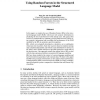1091 search results - page 78 / 219 » Learning Models for Predicting Recognition Performance |
ICASSP
2009
IEEE
15 years 6 months ago
2009
IEEE
For effective training of acoustic and language models for spontaneous speech such as meetings, it is significant to exploit the texts available in a large scale, which may not b...
BMCBI
2007
14 years 12 months ago
2007
Background: Predicting a protein’s structural class from its amino acid sequence is a fundamental problem in computational biology. Much recent work has focused on developing ne...
NIPS
2004
15 years 1 months ago
2004
In this paper, we explore the use of Random Forests (RFs) in the structured language model (SLM), which uses rich syntactic information in predicting the next word based on words ...
112
click to vote
ATAL
2007
Springer
15 years 6 months ago
2007
Springer
Activity recognition is a key component for creating intelligent, multi-agent systems. Intrinsically, activity recognition is a temporal classification problem. In this paper, we...
ICIP
2006
IEEE
16 years 1 months ago
2006
IEEE
In the absence of real data for extensive testing of newly designed large-scale biometrics recognition systems a number of solutions are possible including use of resampling metho...

